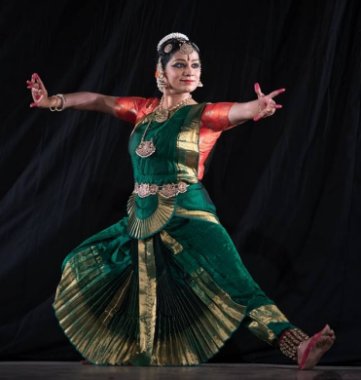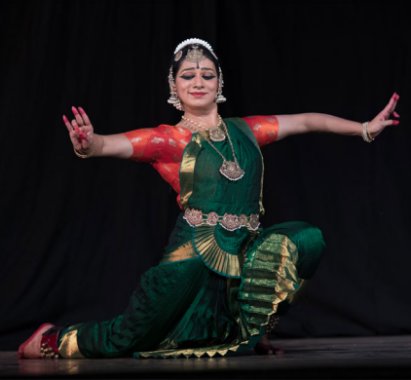
|   |

|   |
Maturity of approach - Jyothi Raghuram e-mail: jyothi.r.ram@gmail.com Photos: Jayasimha Reddy April 14, 2018 Is a solo Bharatanatyam recital passé? Does it no longer hold appeal? Is it a compulsion of the times that the established maargam has to be tweaked to make a recital watchable? The mandate seems to be "something new, something different" for a solo, else have two or more dancers to present the same. One begs to differ - it entirely depends on the dancer to be able to hold audience interest; it is not the medium which is shop-soiled, but the dancer vis a vis his/her understanding and presentation. This was reiterated at the Bharatanatyam recital of Anuradha Vikranth at H. N. Kalakshetra, Bangalore, on April 6, her assured stage presence, mature abhinaya and controlled nritta vouching for the attraction of a solo recital. In fact, one is hesitant to attend a solo show because of the ennui that sets in right from the beginning, lack of conviction of the dancer being primarily responsible for this. One associates Anuradha more with duets and dance features, where she has made her presence felt. What struck one at the recital, from the Ganesha Dwadasha Stotram (Ragamalika) to the varnam, Karunai Seidhida (Shankarabharanam), Javali Nee maatale maayanura, devaranama Aadisidhaleshodhe (Kaapi) and the tillana in Simhendra Madhyama, was the obvious hard work that had gone into it. It is one thing to be self assured, it is entirely another to prove oneself to have substance, gained through years of effort and experience. 

Anuradha's nritta, as in the varnam and tillana, was akin to the gamaka in music, her clear lines and firm foot blending with the gliding, swaying and sliding movements almost as a sequel to the rhythmic aspect, courtesy, the varnam being a Dr. Padma Subrahmanyam dance composition. What was appreciable was that Anuradha had imbibed the movements well enough to make it her own, with no awkward manoeuvres. For a dancer trained in conventional mould, it is not easy to carry off such entire body movements gracefully. Her ardis could do with better definition. The archetypal saamaanya nayika was anything but a clichéd portrayal in the popular javali, the subtle overtones of anger, sarcasm and longing appearing as a natural response to the nayika's grievances vis a vis her nayaka! The Kaapi devaranama was an eye-opener to the creative skills of Anuradha - it was refreshing and simple, even as it highlighted little Krishna's naughtiness that subsequently also reveals his divinity to his mother Yashodha, to whom he is still her darling child. A devaranama, although a lighter abhinaya piece as compared to a javali, was at par with the latter in its emotional content, projecting the dancer as a natural in imaginative choreography and its portrayal. A sober, pleasing recital. Shama Krishna (nattuvangam), Sri Hari (mridangam) and Mahesh Swamy (flute) contributed to the superiority of the recital. The vocal of Raghuram, endowed with a deep voice, was bhava filled, but the sahitya was indecipherable at times. Crucial to dance music is the rapport between the vocalist and dancer, which was found wanting. Jyothi Raghuram is a freelance journalist, dance critic and project writer for UNESCO. A senior journalist with an experience of three decades, she has worked with BBC, PTI, The Hindu and Indian Express. |